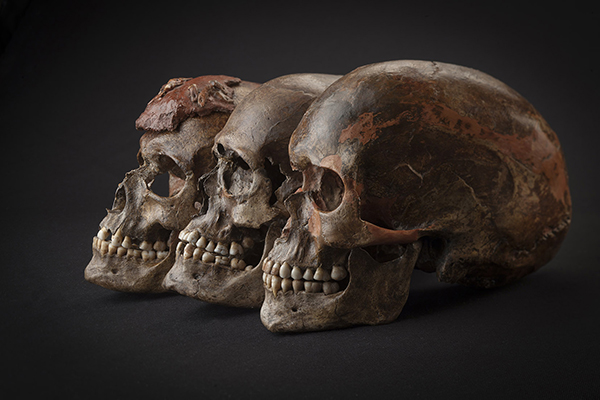By Ana Verayo, | May 03, 2016

These three 35,000-year-old skulls from the Czech Republic were included in the study
Scientists have tracked the ancestry of modern Europeans back to only one group of prehistoric humans that thrived in the northwestern region of the continent some 35,000 years ago. By analyzing the ancient DNA of 51 specimens from ancient Europeans, researchers discovered early migration patterns and routes including population changes that spanned over thousands of years.
Like Us on Facebook
Early humans first established themselves in Europe some 45,000 years ago based on fossil evidence but only little is known about their genetic history before the advent of agriculture and the end of hunter gatherer culture, occurring some 8,000 years ago.
When they arrived and when agriculture became established, Europe was experiencing the last period of the Ice Age as ice sheets that were covering northern Europe and Scandinavia began to melt and retreat between 25,000 to 19,000 years ago.
In this new study, a team from Harvard University led by David Reich conducted the most intensive analysis of this early human European DNA ever. Prior studies only presented prehistoric genetic data from only four individual ancient European specimens. Reich says that these four prehistoric European DNA samples cannot simply represent the entire historical ancestry of Europe, comparing this to summarizing a movie with only four still images.
During genetic data analysis of these 51 new samples, the team was able to create the most extensive and in depth analysis of their findings that also revealed the important genetic changes and distribution over time. Among these major changes are two population transformations between 45,000 to 7,000 years ago.
These two major population changes revealed how the Ice Age caused an exodus of modern European populations from this founding group that originally comes from the northwestern region of the continent some 35,000 years ago.
When this occurred, the founding group became displaced where they transferred to the southwestern part of Europe some 19,000 years ago. When the ice sheets began to retreat, the same group spread out towards the north and repopulated Europe again.
After this, another major population change began some 14,000 years ago in the continent, as new human populations from the south east including Turkey and Greece began to move into Europe.
Researchers say that these results now document this population turnover and migration that are recurring in European pre-historic events. This new study shows that the population history in Europe from 7,000 years ago has seen multiple episodes of population replacement and immigration on a dramatic scale, during a time when the planet's climate is also changing.
This new study is published in the journal Nature.
-
Use of Coronavirus Pandemic Drones Raises Privacy Concerns: Drones Spread Fear, Local Officials Say

-
Coronavirus Hampers The Delivery Of Lockheed Martin F-35 Stealth Fighters For 2020

-
Instagram Speeds Up Plans to Add Account Memorialization Feature Due to COVID-19 Deaths

-
NASA: Perseverance Plans to Bring 'Mars Rock' to Earth in 2031

-
600 Dead And 3,000 In The Hospital as Iranians Believed Drinking High-Concentrations of Alcohol Can Cure The Coronavirus

-
600 Dead And 3,000 In The Hospital as Iranians Believed Drinking High-Concentrations of Alcohol Can Cure The Coronavirus

-
COVID-19: Doctors, Nurses Use Virtual Reality to Learn New Skills in Treating Coronavirus Patients







